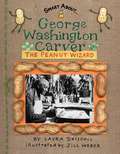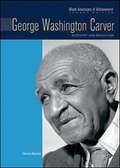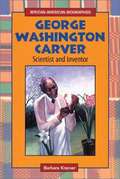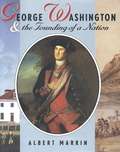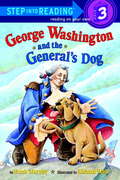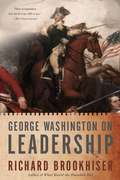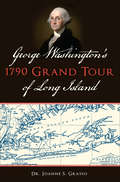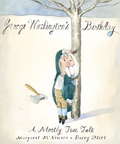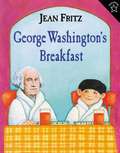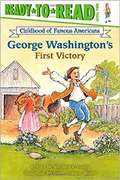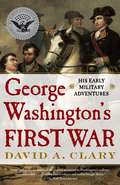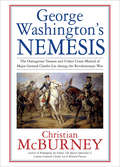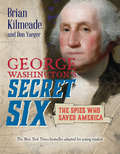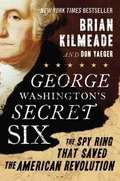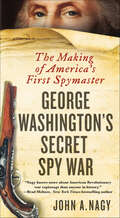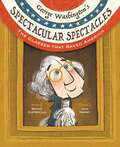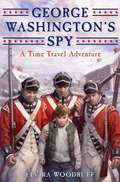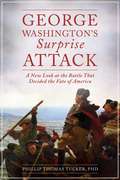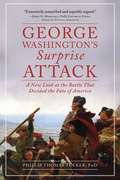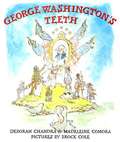- Table View
- List View
George Washington Carver: More Than "The Peanut Man" (Bright Minds)
by Janel RodriguezMeet the inventors and scientists of color who changed the world!Born enslaved during the Civil War in Diamond, Missouri, George Washington Carver was an agricultural scientist and inventor. He promoted alternative crops to cotton and methods to prevent soil depletion. Among his many accomplishments, he developed more than 300 industrial and commercial products from peanuts. It is time to remember how George Washington Carver's inventions and his contributions changed our society… and our world!ABOUT THE SERIES:Many inventors and scientists of color have made incredible contributions to our modern life. Each volume in this much-needed new series will be devoted to the life and work of one of these inventors and scientists. With a vivid writing style that will use humor as one of its primary ingredients, and illustrated with a combination of real photos and pictures featuring graphic art, each title in this series will describe how these heroes of diverse backgrounds faced the challenges of their times, and how their inventions and contributions changed our society.
George Washington Carver: Peanut Wizard
by Laura DriscollIntroducing Smart About Scientists! These books feature fascinating biographical information about the world's greatest scientists, ideas on scientific thinking, and real science experiments kids can try at home. Annie Marcus is just nuts about peanut butter! When Annie finds out that George Washington Carver was responsible for the popularity of peanuts, she picks him for her scientist report. Annie learns all sorts of fascinating info-George Washington Carver was born into slavery, but his dedication and unquenchable thirst for knowledge drove him to become a professor at a time when most institutions of higher learning were closed to blacks. This title explores Carver's brilliant career and discoveries, as well as his triumph over segregation to become one of the world's most renowned plant experts.
George Washington Carver: Scientist
by Lois P. NicholsonPart of the acclaimed Junior World Biographies series designed especially for younger readers. Here are the life stories of notable African-American men & women presented in an informative & easy-to-read format. Based on the highly praised Black Americans of Achievement series.
George Washington Carver: Scientist and Educator (Black Americans of Achievement--Legacy Edition)
by Dennis AbramsGeorge Washington Carver has long been revered for his contributions to improving the lives of poor Southern farmers. Carver studied to be a scientist at a time when many black Americans could not afford, or were turned away from, universities. He went on to teach and do research at the famed Tuskegee Institute in Alabama, where he became one of the most popular instructors at the school. Carver's efforts have been mythologized, but there is much to learn about his work, which benefited many people. George Washington Carver: Scientist and Educator tells the true story of the man who became a legend in his field.
George Washington Carver: Scientist and Inventor
by Barbara KramerProfiles the dynamic man who began life as a slave and became an artist, agriculturist, university professor, and public speaker who addressed the House Ways and Means Committee on the issue of import tariffs in 1921.
George Washington Williams: A Biography
by John Hope FranklinThis book traces Franklin's forty-year quest for Williams's story, a story largely lost to history until this volume was first published in 1985. The result, part biography and part social history, is a unique consideration of a pioneering historian by his most distinguished successor. Williams (1849-1891), had a remarkable career as soldier, minister, journalist, lawyer, politician, freelance diplomat, and African traveler, as well as a historian. While Franklin reveals the accomplishments of this neglected figure and emphasizes the racism that curtailed Williams's many talents, he also highlights the personal weaknesses that damaged Williams's relationships and career.
George Washington and the American Revolution
by Becky GoldA McGraw Hill Reading, Leveled Books about George Washington and the American Revolution.
George Washington and the Founding of a Nation
by Albert MarrinA fascinating, fast-paced account of our first president's life and times. Albert Marrin examines the "father of our country" from the perspectives of his character, military experience, and also his slaveholding, to assess Washington's role in our history. A born leader with a commanding physique, unwavering self-discipline, and an unconquerable will to succeed, he was also-as Lord Fairfax observed when Washington was only sixteen-"a man who will go to school all his life. " Washington's schools were the rugged country of the French and Indian War, the misery-creating insolvency of the Continental Army, and the agrarian responsibility of his plantation in Mount Vernon. Neither a political theorist nor a firebrand, Washington embodied the virtues of fairness, restraint, and farsightedness that could hold the American colonies together-at least for a while. For, as he said near the end of his life and after two terms as president, "I can clearly foresee that nothing but the rooting out of slavery can perpetuate the existence of our union. "
George Washington and the General's Dog (Step into Reading)
by Richard Walz Frank MurphyBoom! Bang! Guns fire! Cannons roar! George Washington is fighting in the American Revolution. He sees a dog lost on the battlefield. Whose dog is it? How will it find its master? Early readers will be surprised to find out what happens in this little-known true story about America's first president.
George Washington for Kids: His Life and Times with 21 Activities (For Kids series)
by Brandon Marie MillerGeorge Washington comes alive in this fascinating activity book that introduces the leader to whom citizens turned again and again--to lead them through eight long years of war, to guide them as they wrote a new Constitution, and to act as the new nation's first executive leader. Children will learn how, shortly after his death in 1799, people began transforming George Washington from a man into a myth. But Washington was a complex individual who, like everyone, had hopes and fears, successes and failures. In his early 20s, for instance,Washington's actions helped plunge Great Britain and France into war. He later fought for liberty and independence, yet owned slaves himself (eventually freeing them in his will). This book weaves a rich tapestry of Washington's life, allowing kids to connect with his story in 21 hands-on projects based on his experiences and the times in which he lived. Children will learn how to tie a cravat, write with a quill pen, follow animal tracks, sew a lady's cap, plant a garden, roll a beeswax candle, play a game of Quoits, and make a replica of Washington's commander-in-chief flag. The text includes a time line, glossary, websites, travel resources, and a reading list for further study.
George Washington on Leadership
by Richard BrookhiserIn 1799, at the end of George Washington’s long life and illustrious career, the politician Henry Lee eulogized him as: "First in war, first in peace, and first in the hearts of his countrymen. ” Esteemed historian Richard Brookhiser now adds to this list, "First in leadership,” examining the lessons to be learned from our first president, first commander-in-chief, and founding CEO. With wit and skill, Brookhiser expertly anatomizes true leadership with lessons from Washington’s three spectacularly successful careers as an executive: general, president, and tycoon. In every area of endeavor, Washington maximized his strengths and overcame his flaws. Brookhiser shows how one man’s struggles and successes two centuries ago can serve as a model--and an inspiration--for leaders today.
George Washington's 1790 Grand Tour of Long Island
by Dr. Joanne S. GrassoThe story of the first American president’s journey through Brooklyn, Queens, Nassau, and Suffolk, based on his own diary.After being elected president, George Washington set out to tour the new nation, which was desperate for a unifying symbol. He spent five days on Long Island in April 1790, an area recovering from seven years of devastating British occupation. Washington saw it all, from Brooklyn to Patchogue to Setauket and back. He was honored at each stop and wrote extensive diary entries about his impressions of the carriage stops for food and overnight stays at taverns and private homes, as well as his vision for the future of the region. In this book, historian Dr. Joanne S. Grasso traces this momentous journey.Includes maps and illustrations
George Washington's Birthday: A Mostly True Tale
by Margaret Mcnamara Barry BlittFrom award-winning author Margaret McNamara and New Yorker artist Barry Blitt comes this partly true and completely funny story of George Washington's 7th birthday. In this clever approach to history, readers will discover the truths and myths about George Washington. Did George Washington wear a wig? No. Did George Washington cut down a cherry tree? Probably not. Readers young and old who are used to seeing George Washington as an old man, will get a new look at the first president--as a kid. Perfect for classrooms, Presidents' Day, or as a birthday gift.From the Hardcover edition.
George Washington's Breakfast
by Jean FritzGeorge Washington Allen, a boy who never gives up until he finds out what he wants to know, is determined to learn all there is to know about his namesake.
George Washington's First Victory (Ready-To-Read COFA)
by Stephen KrenskyDescribes an incident in the early life of George Washington, which provides a glimpse of his relationship with his mother.
George Washington's First War
by David A. Clary"I heard the bullets whistle, and, believe me, there is something charming in the sound." So said the young George Washington, something no veteran soldier would say. He had not been the target of enemy fire. Instead, he was papering over the fact that his men and Indian allies had just massacred a diplomatic party, setting off the French and Indian War of 1754-63. He had violated international law, something else he would not admit. Washington could, after all, tell a lie. That is but one revelation that acclaimed military historian and Washington expert David A. Clary offers in George Washington's First War. Washington spent his adolescence in military service, starting as a colonel in command at the age of twenty-two. He came from a society without a military tradition, and had no training or battle-wise sergeants to keep him out of trouble. He was a young glory hound thrust into circumstances he was not prepared to handle by elders who should have known better. Leading reluctant amateur soldiers against French professionals, when he took command he was on his own. Accordingly, Washington survived a five-year ordeal unlike that endured by any other Founding Father. He emerged from it not yet the steady supreme commander of the Revolution, but he had started on the road that led him to become the great soldier and statesman of his age. How he began his life's journey is what George Washington's First War is about. It is a dramatic story of frontier warfare played out against the anxieties and resentments of an ambitious adolescent. Here are accounts of harrowing ordeals in the wilderness, the decisive part played by the Indian nations whose continent this was, and the epic clash of empires. Others have looked at Washington's activities during the French and Indian War without recognizing that he played his part in that history during his painful transition from boy to man. His repeated blunders and defeats arose from his youthful impetuosity and inexperience and weak support from his government. Clary has a sound understanding of eighteenth-century wilderness warfare, and his descriptions of battles are vivid, exciting, and laced with horrifying details. Brought to dramatic life are Washington's harrowing wintertime journey into the wilderness to order the French to leave the territory, the Jumonville Massacre, his bloody defeat at Fort Necessity, his heroism at the Battle of the Monongahela (Braddock's Defeat), his years of frustration commanding the Virginia Regiment, the Forbes Expedition of 1758, his insubordination to civil and military superiors, and his resignation from the army. A revealing portrait of Washington during a crucial, formative period of his life, this is the indispensable backstory to the making of a great man.
George Washington's Nemesis: The Outrageous Treason and Unfair Court-Martial of Major General Charles Lee during the Revolutionary War
by Christian McBurneyThis biography attempts to set the record straight for a misunderstood military figure from the American Revolution. Historians and biographers of Charles Lee have treated him as either an enemy of George Washington or a defender of American liberty. Neither approach is accurate; objectivity is required to fully understand the war&’s most complicated general. In George Washington&’s Nemesis, author Christian McBurney uses original documents (some newly discovered) to combine two dramatic stories to create one balanced view of one of the Revolutionary War&’s most fascinating personalities. General Lee, second in command in the Continental Army led by George Washington, was captured by the British in December, 1776. While imprisoned, he gave his captors a plan on how to defeat Washington&’s army as quickly as possible. This extraordinary act of treason was not discovered during his lifetime. Less well known is that throughout his sixteen months of captivity and even after his release, Lee continued communicating with the enemy, offering to help negotiate an end to the rebellion. After Lee rejoined the Continental Army, he was given command of many of its best troops together with orders from Washington to attack British general Henry Clinton&’s column near Monmouth, New Jersey. But things did not go as planned for Lee, leading to his court-martial for not attacking and for retreating in the face of the enemy. McBruney argues the evidence clearly shows Lee was unfairly convicted and had, in fact, done something beneficial. But Lee had insulted Washington, which made the matter a political contest between the army&’s two top generals—only one of whom could prevail.
George Washington's Secret Six (Young Readers Adaptation): The Spies Who Saved America
by Brian Kilmeade Don YaegerA page-turning middle-grade adaptation of the New York Times bestseller about George Washington's top-secret spy ring that helped defeat the British.The American Revolution is well under way in 1776, but things are looking bleak for General George Washington and his Continental Army. With Washington's hasty retreat from New York City in August, many think the war might soon be over. After all: how on earth is this ragtag group going to defeat its enemy, the well-trained and well-funded military of the largest empire in history? But Washington soon realizes he can't win with military might. Instead, he must outsmart the British, so he creates a sophisticated intelligence network: the top-secret Culper Spy Ring. Drawing on extensive research, Brian Kilmeade and Don Yaeger tell the fascinating stories of these long unrecognized spies: a reserved merchant, a tavern keeper, a brash young longshoreman, a curmudgeonly Long Island bachelor, a coffeehouse owner, and a mysterious woman.This vivid and accessible young readers adaptation of the New York Times bestseller features an exclusive new introduction, extensive back matter, and eye-catching art throughout. Chronicling a crucial moment in American history, this historical thriller will excite and inspire the next generation of patriots.
George Washington's Secret Six: The Spy Ring That Saved The American Revolution
by Brian Kilmeade Don Yaeger"As a Long Islander endlessly fascinated by events that happened in a place I call home, I hope with this book to give the secret six the credit they didn't get in life. The Culper spies represent all the patriotic Americans who give so much for their country but, because of the nature of their work, will not or cannot take a bow or even talk about their missions. "--Brian Kilmeade When General George Washington beat a hasty retreat from New York City in August 1776, many thought the American Revolution might soon be over. Instead, Washington rallied--thanks in large part to a little-known, top-secret group called the Culper Spy Ring. Washington realized that he couldn't beat the British with military might, so he recruited a sophisticated and deeply secretive intelligence network to infiltrate New York. So carefully guarded were the members' identities that one spy's name was not uncovered until the twentieth century, and one remains unknown today. But by now, historians have discovered enough information about the ring's activities to piece together evidence that these six individuals turned the tide of the war. Drawing on extensive research, Brian Kilmeade and Don Yaeger have painted compelling portraits of George Washington's secret six: Robert Townsend, the reserved Quaker merchant and reporter who headed the Culper Ring, keeping his identity secret even from Washington; Austin Roe, the tavern keeper who risked his employment and his life in order to protect the mission; Caleb Brewster, the brash young longshoreman who loved baiting the British and agreed to ferry messages between Connecticut and New York; Abraham Woodhull, the curmudgeonly (and surprisingly nervous) Long Island bachelor with business and family excuses for traveling to Manhattan; James Rivington, the owner of a posh coffeehouse and print shop where high-ranking British officers gossiped about secret operations; Agent 355, a woman whose identity remains unknown but who seems to have used her wit and charm to coax officers to share vital secrets. In" George Washington's Secret Six," Townsend and his fellow spies finally receive their due, taking their place among the pantheon of heroes of the American Revolution.
George Washington's Secret Spy War: The Making of America's First Spymaster
by John A. NagyThis “fast-paced chronicle reveals a little-known side of America’s Revolutionary War hero”—and how intelligence helped him defeat the British (Publishers Weekly).Here is the untold story of how George Washington used his skills as a spymaster to win the Revolutionary War. Author John A. Nagy has become the nation’s leading expert on the subject, discovering hundreds of spies who went behind enemy lines to gather intelligence during the American Revolution, many of whom are completely unknown to most historians.Drawing on Washington’s personal diaries, Nagy recounts how he honed his intelligence gathering skills during the French and Indian War. He later depended on those skills as he faced a well-trained, better-equipped fighting force in the Revolutionary War. Espionage was Washington’s secret weapon, and he exploited it to extraordinary effect.Filled with thrilling and never-before-told stories from the battlefield and behind enemy lines, this is the story of how Washington out-spied the British. For the first time, readers will discover how espionage played a major part in the American Revolution and why Washington was a master at orchestrating it.
George Washington's Spectacular Spectacles: The Glasses That Saved America
by Selene CastrovillaDid you know that George Washington had a secret? He wore glasses! While initially embarrassed by his reliance on this reading aid, Washington&’s spectacles proved to be nothing short of spectacular in this charming, funny, and little-known picture book story from American history.The Revolutionary War was over, but Washington&’s officers had not received their wages from the Continental Congress in years. Afraid they would never get their money, the officers planned to storm Congress and demand it right away. Luckily, George Washington found out about the plot just in time. He delivered a passionate speech to his men, but they were unaffected. It was only when he struggled to read aloud a letter from Congress and had to put on his glasses, that they realized how much he had sacrificed for their country along with them. The officers dropped their plan and pledged their loyalty to America and to Washington.Selene Castrovilla&’s carefully researched yet playful prose and Jenn Harney&’s energetic, original illustrations bring George Washington&’s more human side to life in this humorous but important story about true American loyalty.
George Washington's Spy: A Time Travel Adventure
by Elvira WoodruffA carefree autumn night takes a dangerous turn when six fifth-grade friends and a seven-year-old little sister find themselves mysteriously swept back in time to 1776--to the British occupation of Boston! The girls are taken in by a family of redcoat loyalists while the boys are recruited as patriot spies. As the children become embroiled in opposite sides of the war, they learn first-hand how ideological differences tore friends and families apart. Sprinkled with just enough humor, Elvira Woodruff has crafted an action-packed, highly dramatic sequel to her most popular book, George Washington's Socks.
George Washington's Surprise Attack
by Phillip Thomas TuckerLike many historical events, the American Revolution is sometimes overlooked, ignored, or minimized by historians due to being shrouded in romantic myth and stubborn stereotypes. Here historian Phillip Thomas Tucker provides an in-depth look at the events of the Battle of Trenton, weeding out fiction and legend and presenting new insights and analysis. Stories from many forgotten individuals of the war, including officers and soldiers from both sides, bring to life the Continental army's desperate circumstances and shocking victory. Myths that Tucker debunks include the Hessians' slovenly drunkenness, Washington acting alone in creating the attack strategy, and Rall's incompetence as a leader contributing widely to his troops' defeat.By exploring the forgotten aspects of one of America's most famous battles, Trenton's story proves to be even more revealing and fascinating. In the end, America's founding was nothing short of miraculous, and no chapter of America's story was more miraculous than Washington's improbable success at the battle of Trenton, where America's fate was decided to almost everyone's amazement on a dark, snowy morning.
George Washington's Surprise Attack: A New Look at the Battle That Decided the Fate of America
by Phillip Thomas TuckerExtensively researched and superbly argued in Tucker’s compelling narrative, this in-depth examination of George Washington’s 'military miracle’ at the Battle of Trenton unquestionably confirms the vital importance of that stunning victory.” -Jerry D. Morelock, PhD, editor in chief at Armchair GeneralLike many historical events, the American Revolution is sometimes overlooked, ignored, or minimized by historians because of common shrouding in romantic myth or interference from stubborn stereotypes. Here historian Phillip Thomas Tucker provides an in-depth look at the events of the Battle of Trenton, weeding out fiction and legend and presenting new insights and analysis. Stories from many forgotten individuals of the war, including officers and soldiers from both sides, bring to life the Continental Army’s desperate circumstances and shocking victory. Myths that Tucker debunks include the Hessians’ slovenly drunkenness, Washington acting alone in creating the attack strategy, and Rall’s incompetence as a leader largely contributing to his troops’ defeat.By exploring the forgotten aspects of one of America’s most famous battles, revealing Trenton’s story proves to be even more fascinating. In the end, America’s founding was nothing short of miraculous, and no chapter of America’s story was more miraculous than Washington’s improbable success at the battle of Trenton, where America’s fate was decided to almost everyone’s amazement on a dark, snowy morning.Skyhorse Publishing, as well as our Arcade imprint, are proud to publish a broad range of books for readers interested in history--books about World War II, the Third Reich, Hitler and his henchmen, the JFK assassination, conspiracies, the American Civil War, the American Revolution, gladiators, Vikings, ancient Rome, medieval times, the old West, and much more. While not every title we publish becomes a New York Times bestseller or a national bestseller, we are committed to books on subjects that are sometimes overlooked and to authors whose work might not otherwise find a home.
George Washington's Teeth
by Brock Cole Deborah Chandra Madeleine ComoraThe creators of George Washington's Teeth unhinge the jaws of history to examine the mouth of America's first president, tracking the poor man's dental woes as he gallops to war, crosses the Delaware, and, with only two teeth left, takes his place as leader of the country. Washington was plagued by black, rotting teeth from the time he was 22, losing about one a year until he was nearly "toofless" and had to have his first dentures made from a hippotamus tusk (that's right, not wood!). Poets Deborah Chandra and Madeleine Comora begin their quirky historical tale at a lively clip: "The Revolutionary War/ George hoped would soon be won,/ But another battle with his teeth/ Had only just begun..." Indeed. Evidently he was losing teeth even as he crossed the Delaware: "George crossed the icy Delaware/ With nine teeth in his mouth./ In that cold and pitchy dark,/ Two more teeth came out!" (Cleverly, illustrator Brock Cole mimics Emanuel Leutze's famous painting "Washington Crossing the Delaware," making Washington seem more uncomfortably tight-lipped than dignified.) The story ends happily ever after with the crafting of a nice new pair of ivory false teeth that allow George to dance around the ballroom through the night. Truth be told, however, he would be deeply troubled by his teeth until the day he died. A four-page, illustrated historic timeline of Washington's life (and mouth) completes this carefully researched, very funny, charmingly illustrated picture book that works to humanize a larger-than-life historical figure and in turn, history itself. Brilliant! (Ages 7 and older) --Karin Snelson

